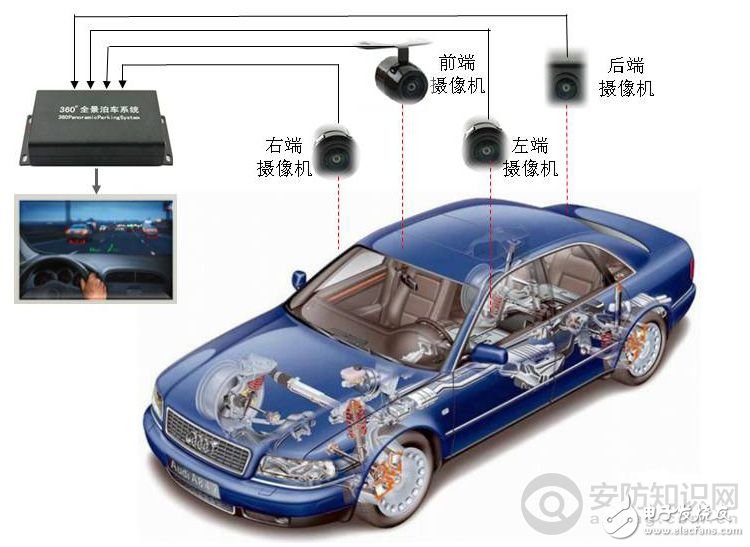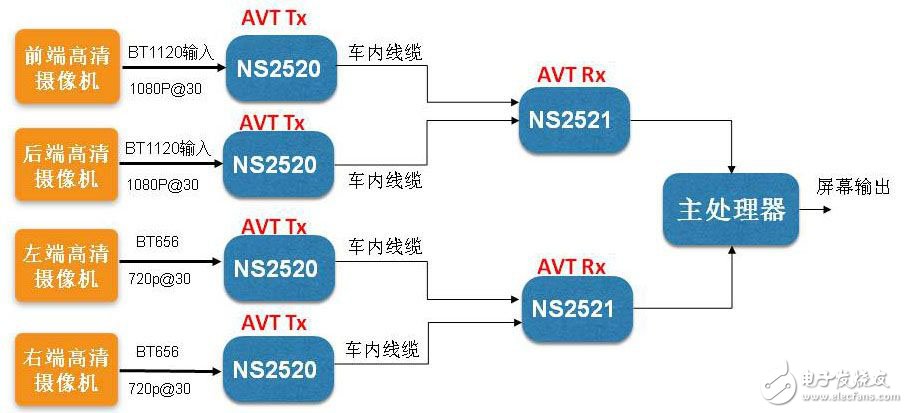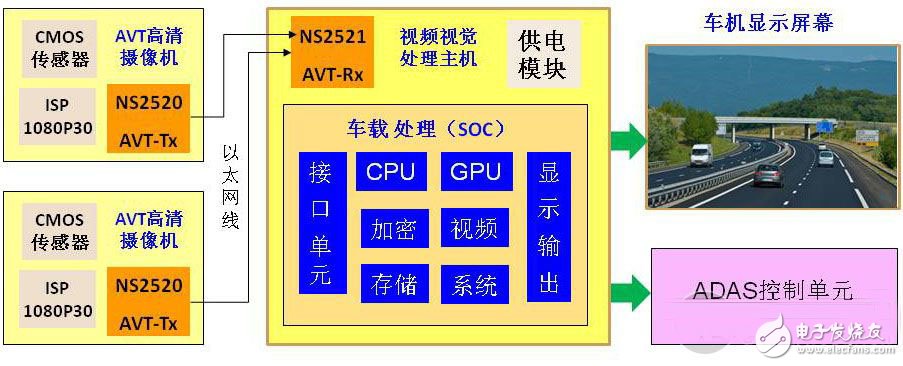This paper first analyzes the technical characteristics of AVT technology in coaxial high-definition digitalization, and then introduces related system solutions and implementations in combination with practical applications, and finally looks forward to its prospects for improving the security of vehicle vision applications.
Car video surveillance has become an important application area covered by digital video surveillance technology. Due to various considerations such as car and driving safety, the video and vision systems involved must be stable and reliable, and the video transmission is more strict. Claim. The digitalization of video transmission has become an inevitable trend of development. Advanced Video Transfer (AVT), as a digital coaxial high-definition video transmission technology, fully supports the high-definition video equipment of vehicles with its superior image performance and outstanding system characteristics. Visual lossless and real-time transmission is beneficial for extending video recording to ADAS-related video applications. This paper first analyzes the technical characteristics of AVT technology in coaxial high-definition digitalization, and then introduces related system solutions and implementations in combination with practical applications, and finally looks forward to its prospects for improving the security of vehicle vision applications.
The ideal of car vision shines into reality
After video surveillance began to spread, traffic became an important area for expanding applications in the industry. In addition to implementing video surveillance on the road, car video equipment is gradually installed inside the vehicle to collect video information and perform subsequent processing in time, which opens the era of vehicle monitoring. The early car video system was mainly a video recorder. Its purpose was to record the video images around the vehicle during driving. The camera was installed only in the front of the car, and the captured video was digitally compressed and stored. The delay is not too high. In order to expand the video surveillance range, a camera is added at the rear to increase the recording channel. Multiple channels of video can be processed separately or transmitted to the front-end processor for synthesis, and there is no special requirement for the means and quality of signal transmission.
With the advent of intelligent video processing technology, the video captured by the camera installed in the car can be analyzed and processed in real time, so as to provide early warning or warning to the situation that may occur in the driving, and the vehicle device has certain visual functions. This makes it possible to achieve an assisted driving effect. The car video system can be divided into two categories according to the application, one is a 360° panoramic video driving system, also known as a surround vision system; the other is a car rear view monitoring system. The system components and video transmission methods involved are described below.
As shown in Fig. 1, the 360° panoramic driving system is composed of a camera and a host computer in front and rear of the car. Each of the four cameras uses a fisheye lens to capture a wide-angle image and send it to the host to image. Splicing, trimming, etc., to generate a 360° panoramic picture, and then output to the LCD display. At present, the mainstream 360° panoramic products on the market mainly rely on standard definition solutions. The main reason is that when the pixels are low, the main processor capability of the panoramic host solution is not high. As more and more host chips provide vendor intervention, processor performance is growing, from dual-core to quad-core, and even to eight-core.
Therefore, the problem of processor power has basically been solved, and its performance is strong enough to support the load of HD video. Secondly, the 1280*600 resolution of the car screen was not high. With the popularity of the 720P HD resolution car-level display, the demand for HD monitoring of the car became more urgent. Each camera needs to be stable and reliable through the cable. High-definition video signals are transmitted to the host, so it is imperative to provide high-capacity and high-reliability digital high-definition video transmission.

Figure 1.360° panoramic driving system
The rear view monitoring system of the car is a big turning point in the form of the product on the driving recorder. From the previous product specification that meets the requirements of more users and users with different specifications and different configurations to meet the needs of more users. market. Before the popularization of the 360° panoramic driving system, the demand for the rear view monitoring system of the automobile was very high. It is reported that the monthly capacity of the market capacity has reached more than one million sets. Because the solution is cheap and the installation scheme is simple, only a small camera is needed at the rear license plate light. When the car starts to reverse, the screen automatically switches to the image of the reversing camera to achieve the function of assisting the owner to reverse. Similarly, with the popularity of high-definition screens, more and more car owners are increasingly demanding high-definition cameras, so focusing on automotive rear-view applications, digital HD is also facing great opportunities.
With the gradual increase of products, there are more main control chip manufacturers to participate in the competition, for example, Quanzhi mainly pushes T3 series and V series chips; MediaTek launches intelligent rear view video chip; Mercedes is the application of the core 1860 chip Representative solution providers; Rockchip and Intel jointly launched the codename Sofia3G-R will also be mass-produced; there are also players equipped with Qualcomm platform and other programs.
Innovative means of video transmission in the car
Digital high-definition video transmission technology has an extraordinary significance for improving the performance and quality of car video equipment. It is not only used to improve the image quality and clarity of car video sources, but also to provide visual lossless and real-time video transmission means. In the automotive market, there is a need for both front-loading and post-installation equipment, and we are looking forward to adopting more efficient and reliable innovations in high-definition video transmission.
Looking at the wiring inside the car is very complicated, and the reliability requirements are very high, and there is not much selectivity left for the video connection. Ordinary AV audio and video cables are obviously not suitable for use in the car, so you need to consider the choice of coaxial cable or Ethernet cable. For high-definition video transmission, coaxial high-definition transmission system is currently popular, and the analog coaxial high-definition transmission system is mainly applied to high-definition video surveillance cameras such as AHD, HD-TVI and HD-CVI, while the digital coaxial HD system is not AVT. It belongs.
HD-TVI, HD-CVI, and AHD are high-definition video transmission specifications based on coaxial cable. They are analog high-definition solutions, which are implemented by intra-frame frequency addition, except that the frequency of each frequency is different. The means of implementation are basically the same as the methods. The advantage of this implementation is that the solution cost is low, and the image quality can be improved to 12,000 megapixels compared with the standard definition effect, which is called analog high definition. However, because the image is increased by intra-frame frequency addition. The pixel points cause the intra-frame frequency to increase, and the resulting image color interference is difficult to avoid. Although the ISP processing can make up for the defects of some people's eyes, such programs are popular in the industrial monitoring market. However, for the automotive market, in addition to satisfying the human eye, the main chip platform needs to be collected. Video to do intelligent analysis and processing, to achieve machine vision effects, such as automatic parking technology and more assisted driving, and future unmanned technology need to accurately capture the video, to ensure that these videos accurately send and receive, you must achieve complete Digital transmission. If the analog signal mode is still used in the transmission process, the loss of the video or even the loss of the video in the complex application environment of the vehicle is greatly reduced, which leads to the significant reduction of the recognition capability of the main control chip for the HD video, and this is indeed The automation and security of the car video system is unacceptable.
As a new digital coaxial transmission technology, AVT technology combines the features of all-digital architecture and digital signal transmission to overcome the limitation of transmission distance caused by the attenuation of digital signals on transmission cables. A new generation of digital video compression algorithm is adopted. It is more efficient than the standard VC-2 LD compression algorithm, and the video delay is as small as one frame period, less than 3 milliseconds. Therefore, the AVT is truly visually lossless, and the human eye is completely unaware of the loss and delay of the HD video signal, which can be regarded as a real-time effect.
The visual lossless compression technique used by AVT differs from the original image by less than -40dB, the image quality is comparable to digital uncompressed transmission, and the image quality does not vary with distance, wire, temperature, etc. In contrast, analog coaxial high-definition requires the use of a DAC to become an analog signal before transmission, and the ADC needs to be converted back to a digital signal at the receiving end. The two conversions inevitably cause video loss and deteriorate image quality. In addition, analog video signals cause nonlinear attenuation during transmission, resulting in more image quality loss. Another serious problem with analog coaxial high-definition is that the sampling clock recovered by its receiving end has a large jitter, which will result in inaccurate sampling position of the ADC at the receiving end, thereby making the image quality after analog coaxial high-definition transmission. Poor, and the image quality between different machines is not the same, the dispersion is large and the problem of poor consistency, and with temperature changes. Therefore, it is not suitable for an application scenario in which the image quality is high and the temperature range is greatly changed.
AVT also has an innovative rate adaptive transmission technology that adaptively adjusts the digital compression ratio based on the distance traveled and the attenuation of the signal to achieve the best video image. Therefore, high-definition video transmission is no longer affected by the external environment, and it is also conducive to the upgrading of future products. In addition, AVT can also realize bidirectional data transmission, support UART, IR, I2C (master/slave) bidirectional transparent transmission and SPI forward transparent transmission on the control interface; on the audio interface, AVT supports SPDIF, I2S 8/16/ Bidirectional transmission of 24/32/44.1/48/96Kbps sampling rate; AVT supports Cat 5 Ethernet cable transmission for wire usage. In fact, you can use one of them to transmit a high-definition video on a twisted pair. If you use the Ethernet cable, you can transmit four high-definition video, so it is very suitable for car wiring in car video equipment, convenient for the multi-function of the vehicle system and the development of the ADAS system.
Combined with the application of the 360° panoramic driving system, the AVT is shown in the block diagram of the panoramic parking system.
Based on AVT technology, the designed chip NS2520 is the transmitter (Tx), while the NS2521 chip is the receiver (Rx), which can support two-way. The NS2520 serially encodes the parallel signal output from the camera ISP. The video input interface is compatible with 10/20 bit width and has multiple video formats such as BT656/1120, CEA-861, CPI, and DVP. The maximum support is 1080P@30fps. SPDIF/I2S audio embedding. A piece of NS2521 can be used with two NS2520s to fully support the above format.

Figure 2. AVT in the panoramic parking system block diagram
The future of assisted driving is infinitely bright
With the intelligent development of the automotive industry, the Advanced Driver Assistant System (ADAS) will be popular in the city, and various ADAS-related video systems will continue to emerge, in addition to the introduced panoramic parking and rear view. The monitoring system will also have adaptive cruise control system, lane keeping system, front collision warning, lane departure warning, brake assist system, rear monitoring system, night vision system, driver anti-fatigue monitoring system and traffic signal recognition system. These require your high-definition real-time video as a guarantee to improve the video image quality and clarity of the car video source, while real-time large-capacity reliable video transmission is critical for ADAS applications. Traditional video high-speed transmission uses analog coaxial cable, but due to various electromagnetic radiation in the car, it is easy to cause multiple interferences. For high-definition video with a resolution of 1080P, the bandwidth will be as high as three megabytes. Under the complicated conditions of the internal wiring of the vehicle, high reliability requirements must be met. Digitization and networking can compress video and transmit it over an Ethernet cable, but inevitably introduce network latency. As an advanced video transmission technology, AVT adopts digital coaxial high-definition transmission mode, but can effectively transmit high-definition video signals with low loss of vision and low latency by means of universal Ethernet cable. Therefore, AVT digital high-definition transmission solution application will help Advance in the automotive visual market.
As shown in Figure 4, the AVT HD camera is used in the ADAS system. The AVT chip is used to implement the new AVT HD camera. The high-definition video capture part of the CMOS sensor and ISP processing unit is highly coupled with the AVT transmit chip NS2520. The video is seamlessly connected, and the digital HD video signal is directly output and transmitted through the Ethernet cable. On the host computer, the transmission signal in the car can be received by the NS2521 and restored to a visually lossless digital HD video signal with extremely low latency, which is then processed by the main processor in real time. The result of the processing is displayed on the screen of the output, and is also output to the control unit of the ADAS to adjust the situation encountered during the running of the car. It should be noted that two AVT cameras can share one NS2521 receiving unit. If you need to connect more AVT cameras, you need to add more NS2521 chips in the host design.

Figure 3. Application of AVT HD camera in ADAS system
In recent years, the automotive video market dominated by smart rearview mirrors and smart driving recorders has shown a blowout situation, with shipments starting at tens of millions. The convergence of in-vehicle video products has emerged. The combination of vehicle navigation, in-vehicle multimedia, and in-vehicle entertainment is undergoing a process from SD to HD, from analog to digital, from single function to intelligent multi-function conversion, among which digital HD video Transmission technology will play an extremely important role.
This year is the first year of China's smart driving assistance system market. ADAS will be mainly used for monitoring, early warning, braking and steering tasks. Its demand will be expected to maintain rapid growth in the next decade. It is a safety measure to protect drivers and effectively reduce accidents. There are both regulatory requirements and consumers. s concern. From an international perspective, both the European Union and the United States are obliged to require all motor vehicles to be equipped with autonomous emergency braking systems and forward collision warning systems by 2020. According to a report by the latest international survey agency, car buyers are increasingly interested in ADAS systems that offer the same comfort and economy as the auxiliary parking system or rear blind spot monitoring.
As processors and sensors are expected to account for the majority of sales, semiconductor companies are considering competing in these areas by offering distinctive products, along with improvements in video vision processors, with complete system solutions, not only in post-installation The market will also have a place in the pre-installation market. Therefore, the AVT series chips have undergone rigorous design and strict manufacturing processes and tests to meet the requirements of the vehicle regulations. AVT supports 4K & TImes; 2K chips will be launched in the second half of the year, and will fully support the ultra-HD ADAS requirements.
Cbd Vape Products Oem,D8 Vape Pen Oem,Cbd Disposable Vape Pen Oem,China Cbd Vape Products Oem
Shenzhen MASON VAP Technology Co., Ltd. , https://www.disposablevapepenfactory.com